Qualcomm Snapdragon 805 Performance Preview
by Anand Lal Shimpi on May 21, 2014 8:00 PM EST- Posted in
- Tablets
- Snapdragon
- Qualcomm
- Mobile
- SoCs
- Snapdragon 805
CPU Performance
As always we'll start out our performance investigation with a handful of CPU bound web browser based tests. In all cases we used Chrome on the MDP/T. Remember there's only an 8% increase in peak CPU frequency here, so I wouldn't expect a huge difference vs. Snapdragon 801.
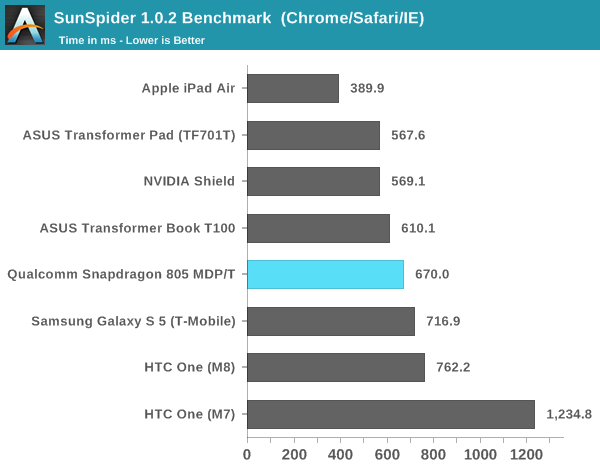
Here the MDP/T scales pretty well, showing a 6% improvement in performance over the Snapdragon 801 based Galaxy S 5. In the case of the GS5 we are looking at a 2.5GHz Snapdragon 801 implementation, so the improvement makes sense. Both the Cortex A15 (TF701T/Shield) and Apple's Cyclone (in the iPad Air) are higher performing designs here. Since there's no fundamental change to Krait's IPC, the only gains we see here are from the higher clock speed.
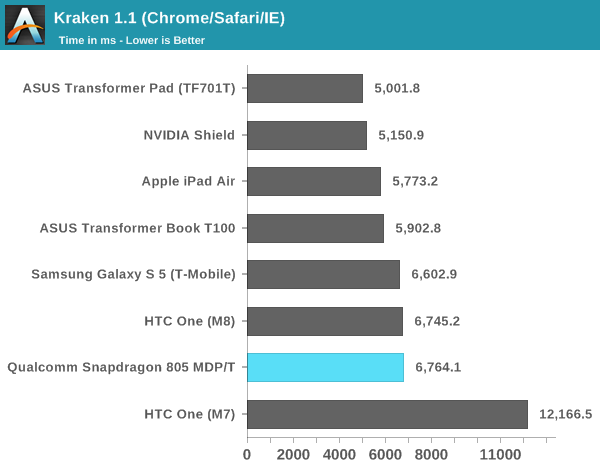
Kraken appears to be at its limit when it comes to Krait 400/450, there's effectively no additional frequency scaling beyond 2.3GHz. We're either running into an architectural limitation or limits of the software/browser combination itself.
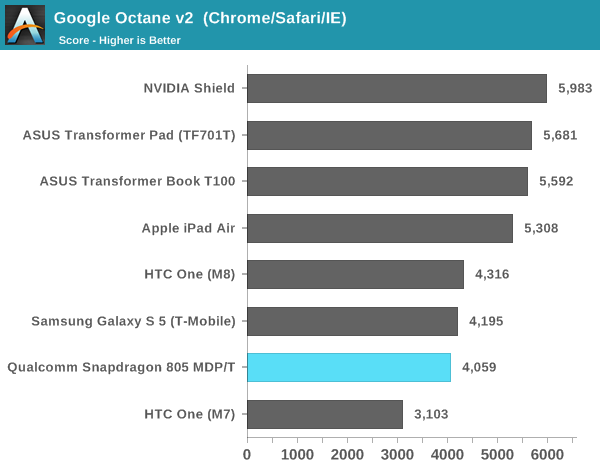
Similarly we don't see any real progress in the Google Octane test either. Snapdragon 805's CPU cores may run at a higher peak frequency but that's definitely not the story here.
Basemark OS II
Basemark OS II gives us a look at native application performance across a variety of metrics. There are tests that hit the CPU, GPU as well as storage subsystems here. The gains here are exclusively on the graphics side, which makes sense given what we've just seen. Snapdragon 805's biggest gains will be GPU facing.
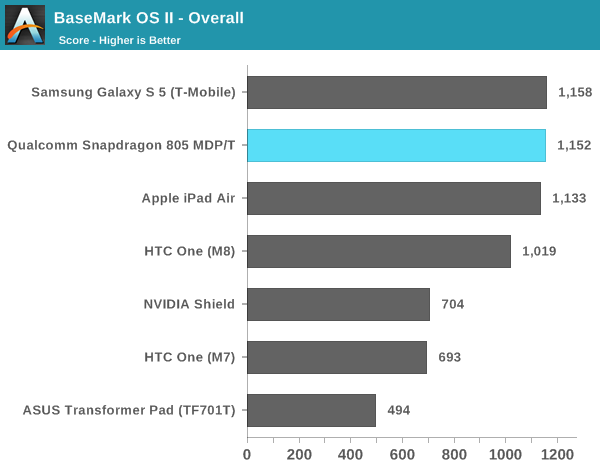
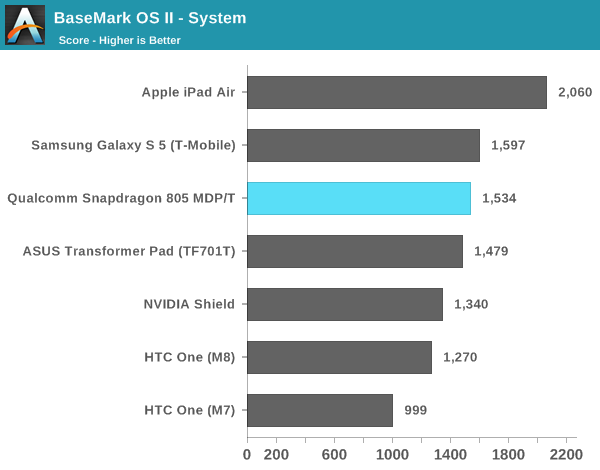


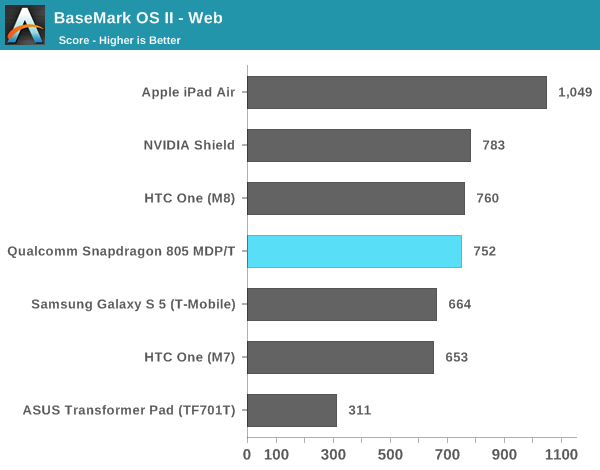
Geekbench 3.0
Although I don't typically use Geekbench, I wanted to include some numbers here to highlight that the increase in memory bandwidth for S805 over S801 doesn't really benefit the CPU cores:
| Geekbench 3.0 | |||||
| Snapdragon 801 2.3GHz (HTC M8) | Snapdragon 805 2.7GHz (MDP/T) | % Increase for S805 | |||
| Overall (Single thread) | 1001 | 1049 | 4.8% | ||
| Overall (Multi-threaded) | 2622 | 2878 | 9.7% | ||
| Integer (Single thread) | 956 | 996 | 4.2% | ||
| Integer (Multi-threaded) | 2999 | 3037 | 1.3% | ||
| FP (Single thread) | 843 | 925 | 9.7% | ||
| FP (Multi-threaded) | 2636 | 3155 | 19.7% | ||
| Memory (Single thread) | 1411 | 1406 | 0% | ||
| Memory (Multi-threaded) | 1841 | 1949 | 6% | ||
I wouldn't read too much into the multithreaded FP results, I suspect we're mostly seeing differences in thermal dissipation of the two test units. A closer look at the memory bandwidth numbers confirms that while the 805 has more memory bandwidth, most of it is reserved for GPU use:
| Geekbench 3.0 - Memory Bandwidth | |||||
| Snapdragon 801 2.3GHz (HTC M8) | Snapdragon 805 2.7GHz (MDP/T) | % Increase for S805 | |||
| Stream Copy (Single thread) | 7.89 GB/s | 8.04 GB/s | 1.9% | ||
| Stream Copy (Multi-threaded) | 9.53 GB/s | 10.1 GB/s | 5.9% | ||
| Stream Scale (Single thread) | 5.36 GB/s | 5.06 GB/s | - | ||
| Stream Scale (Multi-threaded) | 7.31 GB/s | 7.63 GB/s | 4.3% | ||
| Stream Add (Single thread) | 5.27 GB/s | 5.2 GB/s | - | ||
| Stream Add (Multi-threaded) | 6.84 GB/s | 7.51 GB/s | 9.8% | ||
| Stream Triad (Single thread) | 5.64 GB/s | 5.85 GB/s | 3.7% | ||
| Stream Triad (Multi-threaded) | 7.65 GB/s | 7.89 GB/s | 3.1% | ||










149 Comments
View All Comments
testbug00 - Thursday, May 22, 2014 - link
Yeah, it supports DX11.2.... no other mobile GPU supports... Wait. Qualcomm does... And I wonder how long until ARM "stock" GPU does... And Imagine Tech's...Nvidia is not displacing Qualcomm most likely. It could happen, but, given OEM relationships, it is unlikely. Even if NVidia has a better product (note: I think they have one that is on best even with Qualcomm (for Phones)) the OEM relations mean a lot. ATI managed to make quite a bit of money despite NVidia having far better products due to OEM relationships.
kron123456789 - Thursday, May 22, 2014 - link
"Yeah, it supports DX11.2.... no other mobile GPU supports... Wait. Qualcomm does... And I wonder how long until ARM "stock" GPU does... And Imagine Tech's..." — Only Tegra K1 supports OpenGL 4.4. DirectX support matters ONLY on Windows. And Tegra K1 supports DirectX 12(because of that: http://blogs.nvidia.com/blog/2014/03/20/directx-12... ).tuxRoller - Friday, May 23, 2014 - link
Why does opengl 4.4 matter? Who would consume it?http://richg42.blogspot.com/2014/05/the-truth-on-o...
fivefeet8 - Friday, May 23, 2014 - link
Unfortunately, OpenGL 4.x will mean little to Android devices until Qualcomm starts actually caring about the API in their drivers. If the K1 actually competes in tablets and superphones, it may actually have the effect of forcing them to through competition.https://dolphin-emu.org/blog/2013/09/26/dolphin-em...
tuxRoller - Friday, May 23, 2014 - link
Look, you don't need to keep linking to that old post. I'm don't need to argue about adreno blob quality. Nvidia, however, lives and breathes on it software, which seems to be not quite as flawless as some would believe.Again, why does gl matter to android? It doesn't even support it. The point of having the embedded profile is to expose enough of gl to create a good balance between high performance/graphics quality and efficiency. Going full blown gl destroys that last advantage (tesselation alone is terrible for battery life).
kron123456789 - Friday, May 23, 2014 - link
Serious Sam 3 for Tegra K1 is using OpenGL 4(and Croteam have Android build that supports OpenGL 4).tuxRoller - Friday, May 23, 2014 - link
Great, but you aren't going to see Google including gl in their builds. The reason? Gles is the best of what can be supported while maintaining decent battery.fivefeet8 - Thursday, May 22, 2014 - link
Hardware level support for API's mean diddly squat if their drivers are crap. My Galaxy S4 with the Snapdragon 600 supports OpenGLes3, but it sucks at it. Nvidia actually has a history of nominal OpenGL support in drivers at least.ams23 - Thursday, May 22, 2014 - link
Who said anything about NVIDIA "displacing" Qualcomm? That is pure silliness. NVIDIA offers a "differentiated" product. Any OEM who wants to offer differentiated high end products may consider using Tegra K1. K1 is also a very versatile product, so it will be used in a wide variety of different products.ams23 - Thursday, May 22, 2014 - link
Companies like Xiaomi that are looking for differentiated products would absolutely consider using Tegra K1 in a high end smartphone. Considering the performance and perf. per watt advantages for Tegra K1, there are clearly compelling reasons to use it. But again, like I said above, the lions share of phones outside of Apple and Samsung will go to Qualcomm (bundled modem) and Mediatek (lowest cost).